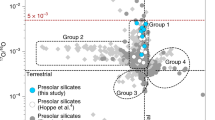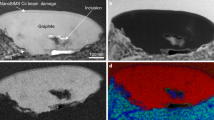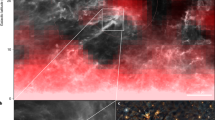Abstract
Pristine stardust grains from the interstellar gas and dust cloud from which our Solar System formed some 4.57 billion years ago are present in small quantities in primitive Solar System materials, such as certain types of meteorite, interplanetary dust particles and cometary matter. As these grains are older than our Solar System, they are known as presolar grains. They can be recognized because they carry large isotopic abundance anomalies that are the result of nucleosynthetic processes in their parent stars, namely, asymptotic giant branch stars, supergiants, supernovae and novae. From astronomical observations and dust-evolution models, it is still not clear to what extent various stellar sources, especially supernovae, contributed dust to the interstellar medium. Since the discovery of presolar grains more than 30 years ago, supernova grains have been considered to be only a minor subpopulation of presolar grains, with relative contributions of ∼10% for silicates, the most abundant type of presolar stardust grains. Recently conducted studies of presolar grains with improved analysis techniques have changed this view considerably, and suggest that supernovae and their progenitors contributed substantially to the dust inventory of the solar nebula, namely, >30% for silicates and >25% in total if other stardust minerals are considered. Here we review the recent findings from studies of presolar grains and discuss implications for future presolar grain studies, interstellar dust models and the interpretation of astronomical observations of dust in supernova ejecta.
This is a preview of subscription content, access via your institution
Access options
Access Nature and 54 other Nature Portfolio journals
Get Nature+, our best-value online-access subscription
$29.99 / 30 days
cancel any time
Subscribe to this journal
Receive 12 digital issues and online access to articles
$119.00 per year
only $9.92 per issue
Buy this article
- Purchase on Springer Link
- Instant access to full article PDF
Prices may be subject to local taxes which are calculated during checkout





Similar content being viewed by others
References
Dwek, E. The supernova origin of interstellar dust. Science 313, 178–180 (2006).
Zinner, E. in Meteorites and Cosmochemical Processes Vol. 1 Treatise on Geochemistry Update 2 (ed. Davis, A. M.) 181–213 (Elsevier, 2014).
Nittler, L. R. & Ciesla, F. Astrophysics with extraterrestrial materials. Annu. Rev. Astron. Astrophys. 54, 53–93 (2016).
Bernatowicz, T. et al. Evidence for interstellar SiC in the Murray carbonaceous meteorite. Nature 330, 728–730 (1987).
Tang, M. & Anders, E. Isotopic anomalies of Ne, Xe, and C in meteorites. II. Interstellar diamond and SiC: carriers of exotic noble gases. Geochim. Cosmochim. Acta 52, 1235–1244 (1988).
Amari, S., Anders, E., Virag, A. & Zinner, E. Interstellar graphite in meteorites. Nature 345, 238–240 (1990).
Nittler, L. R. et al. Silicon nitride from supernovae. Astrophys. J. 453, L25–L28 (1995).
Hutcheon, I. D., Huss, G. R., Fahey, A. J. & Wasserburg, G. J. Extreme 26Mg and 17O enrichments in an Orgueil corundum: identification of a presolar oxide grain. Astrophys. J. 425, L97–L100 (1994).
Nittler, L. R., Alexander, C. M. O. D., Gao, X., Walker, R. M. & Zinner, E. K. Interstellar oxide grains from the Tieschitz ordinary chondrite. Nature 370, 443–446 (1994).
Messenger, S., Keller, L. P., Stadermann, F., Walker, R. M. & Zinner, E. Samples of stars beyond the Solar System: silicate grains in interplanetary dust. Science 300, 105–108 (2003).
Floss, C. & Haenecour, P. Presolar silicate grains: abundances, isotopic and elemental compositions, and the effects of secondary processing. Geochem. J. 50, 3–15 (2016).
Bose, M., Floss, C. & Stadermann, F. J. An investigation into the origin of Fe-rich presolar silicates in Acfer 094. Astrophys. J. 714, 1624–1636 (2010).
Nguyen, A., Nittler, L. R., Stadermann, F., Stroud, R. & Alexander, C. M. O. D. Coordinated analyses of presolar grains in the Allan Hills 77307 and Queen Elizabeth Range 99177 meteorites. Astrophys. J. 719, 166–189 (2010).
Vollmer, C., Hoppe, P., Stadermann, F. J., Floss, C. & Brenker, F. NanoSIMS analysis and Auger electron spectroscopy of silicate and oxide stardust from the carbonaceous chondrite Acfer 094. Geochim. Cosmochim. Acta 73, 7127–7149 (2009).
Nagashima, K., Krot, A. N. & Yurimoto, H. Stardust silicates from primitive meteorites. Nature 428, 921–924 (2004).
Nguyen, A. N. & Zinner, E. Discovery of ancient silicate stardust in a meteorite. Science 303, 1496–1499 (2004).
Hoppe, P., Cohen, S. & Meibom, A. NanoSIMS: technical aspects and applications in cosmochemistry and biological geochemistry. Geostand. Geoanal. Res. 37, 111–154 (2013).
Hoppe, P., Leitner, J. & Kodolányi, J. New insights into the Galactic chemical evolution of magnesium and silicon isotopes from studies of silicate stardust. Astrophys. J. 869, 47 (2018).
Nittler, L. R., Alexander, C. M. O. D., Liu, N. & Wang, J. Extremely 54Cr- and 50Ti-rich presolar oxide grains in a primitive meteorite: formation in rare types of supernovae and implications for the astrophysical context of Solar System birth. Astrophys. J. Lett. 856, L24 (2018).
Leitner, J. et al. The presolar grain inventory of fine-grained chondrule rims in the Mighei-type (CM) chondrites. Meteorit. Planet. Sci. 55, 1176–1206 (2020).
Huss, G. R. & Lewis, R. S. Presolar diamond, SiC, and graphite in primitive chondrites: abundances as a function of meteorite class and petrologic type. Geochim. Cosmochim. Acta 59, 115–160 (1995).
Anders, E. & Zinner, E. Interstellar grains in primitive meteorites: diamond, silicon carbide, and graphite. Meteoritics 28, 490–514 (1989).
Clayton, D. D. Origin of heavy xenon in meteoritic diamonds. Astrophys. J. 340, 613–619 (1989).
Richter, S., Ott, U. & Begemann, F. Tellurium in pre-solar diamonds as an indicator for rapid separation of supernova ejecta. Nature 391, 261–263 (1998).
Russell, S. S., Arden, J. W. & Pillinger, C. T. A carbon and nitrogen isotope study of diamond from primitive chondrites. Meteorit. Planet. Sci. 31, 343–355 (1996).
Stroud, R. M., Chisholm, M. F., Heck, P. R., Alexander, C. M. O. D. & Nittler, L. R. Supernova shock-wave-induced co-formation of glassy carbon and nanodiamond. Astrophys. J. 738, L27 (2011).
Nittler, L. R., Alexander, C. M. O. D., Gao, X., Walker, R. M. & Zinner, E. Stellar sapphires: the properties and origins of presolar Al2O3 in meteorites. Astrophys. J. 483, 475–495 (1997).
Nittler, L. R. et al. Aluminum-, calcium- and titanium-rich oxide stardust in ordinary chondrite meteorites. Astrophys. J. 682, 1450–1478 (2008).
Nittler, L. R. On the mass and metallicity distributions of the parent AGB stars of O-rich presolar dust. Publ. Astron. Soc. Aust. 26, 271–277 (2009).
Hoppe, P., Leitner, J., Kodolányi, J. & Vollmer, C. Isotope systematics of presolar silicate grains: new insights from magnesium and silicon. Astrophys. J. 913, 10 (2021).
Leitner, J. & Hoppe, P. A new population of dust from stellar explosions among meteoritic stardust. Nat. Astron. 3, 725–729 (2019).
Verdier-Paoletti, M. J., Nittler, L. R. & Wang, J. High-resolution measurements of Mg, Si, Fe and Ni isotopes of O-rich presolar grains. In 82nd Annual Meeting of The Meteoritical Society 6433 (Lunar and Planetary Institute, 2019).
Pignatari, M. et al. Carbon-rich presolar grains from massive stars: subsolar 12C/13C and 14N/15N ratios and the mystery of 15N. Astrophys. J. 808, L43 (2015).
Kobayashi, C., Karakas, A. I. & Umeda, H. The evolution of isotope ratios in the Milky Way Galaxy. Mon. Not. R. Astron. Soc. 414, 3231–3250 (2011).
Timmes, F. X., Woosley, S. E. & Weaver, T. A. Galactic chemical evolution: hydrogen through zinc. Astrophys. J. Suppl. Ser. 98, 617–658 (1995).
Nollett, K. M., Busso, M. & Wasserburg, G. J. Cool bottom processes on the thermally pulsing asymptotic giant branch and the isotopic composition of circumstellar dust grains. Astrophys. J. 582, 1036–1058 (2003).
Palmerini, S., La Cognata, M., Cristallo, S. & Busso, M. Deep mixing in evolved stars. I. The effect of reaction rate revisions from C to Al. Astrophys. J. 729, 3 (2011).
Lugaro, M. et al. Origin of meteoritic stardust unveiled by a revised proton-capture rate of 17O. Nat. Astron. 1, 0027 (2017).
Nittler, L. R., Stroud, R. M., Alexander, C. M. O. D. & Howell, K. Presolar grains in primitive ungrouped carbonaceous chondrite Northwest Africa 5958. Meteorit. Planet. Sci. 55, 1160–1175 (2019).
Rauscher, T., Heger, A., Hoffman, R. D. & Woosley, S. E. Nucleosynthesis in massive stars with improved nuclear and stellar physics. Astrophys. J. 576, 323–348 (2002).
Hynes, K. M. & Gyngard, F. The Presolar Grain Database: http://presolar.wustl.edu/~pgd. In Proc. 40th Lunar and Planetary Science Conference 1198 (Lunar and Planetary Institute, 2009).
Hoppe, P., Leitner, J. & Kodolanyi, J. New constraints on the abundances of silicate and oxide stardust from supernovae in the Acfer 094 meteorite. Astrophys. J. 808, L9 (2015).
Liu, N., Dauphas, N., Cristallo, S., Palmerini, S. & Busso, M. Oxygen and aluminum-magnesium isotopic systematics of presolar nanospinel grains from CI chondrite Orgueil. Geochim. Cosmochim. Acta 319, 296–317 (2021).
Zinner, E. et al. Oxygen, magnesium and chromium isotopic ratios of presolar spinel grains. Geochim. Cosmochim. Acta 69, 4149–4165 (2005).
Dauphas, N. et al. Neutron-rich chromium isotope anomalies in supernova ejecta. Astrophys. J. 720, 1577–1591 (2010).
Qin, L. et al. Extreme 54Cr-rich nano-oxides in the CI chondrite Orgueil—implication for a late supernova injection into the Solar System. Geochim. Cosmochim. Acta 75, 629–644 (2011).
Bose, M., Floss, C., Stadermann, F. J., Stroud, R. M. & Speck, A. K. Circumstellar and interstellar material in the CO3 chondrite ALHA77307: an isotopic and elemental investigation. Geochim. Cosmochim. Acta 93, 77–101 (2012).
Lugaro, M. et al. Isotopic compositions of strontium, zirconium, molybdenum, and barium in single presolar SiC grains and asymptotic giant branch stars. Astrophys. J. 593, 486–508 (2003).
Lugaro, M., Karakas, A. I., Pető, M. & Plachy, E. Do meteoritic silicon carbide grains originate from asymptotic giant branch stars of super-solar metallicity? Geochim. Cosmochim. Acta 221, 6–20 (2018).
Zinner, E. et al. Silicon and carbon isotopic ratios in AGB stars: SiC grain data, models, and the Galactic evolution of the Si isotopes. Astrophys. J. 650, 350–373 (2006).
Amari, S. et al. Presolar SiC grains of type Y: origin from low-metallicity AGB stars. Astrophys. J. 546, 248–266 (2001).
Hoppe, P. et al. Meteoritic silicon carbide grains with unusual Si-isotopic compositions: evidence for an origin in low-mass metallicity asymptotic giant branch stars. Astrophys. J. 487, L101–L104 (1997).
Amari, S., Hoppe, P., Zinner, E. & Lewis, R. S. Interstellar SiC with unusual isotopic compositions: grains from a supernova? Astrophys. J. 394, L43–L46 (1992).
Amari, S., Gao, X., Nittler, L. R. & Zinner, E. Presolar grains from novae. Astrophys. J. 551, 1065–1072 (2001).
José, J. & Hernanz, M. The origin of presolar nova grains. Meteorit. Planet. Sci. 42, 1135–1143 (2007).
Hoppe, P., Pignatari, M., Kodolányi, J., Gröner, E. & Amari, S. NanoSIMS isotope studies of rare types of presolar silicon carbide grains from the Murchison meteorite: implications for supernova models and the role of 14C. Geochim. Cosmochim. Acta 221, 182–199 (2018).
Liu, N., Nittler, L. R., Pignatari, M., Alexander, C. M. O. D. & Wang, J. Stellar origin of 15N-rich presolar SiC grains of type AB: supernovae with explosive hydrogen burning. Astrophys. J. 842, L1 (2017).
Nittler, L. R. & Hoppe, P. Are presolar silicon carbide grains from novae actually from supernovae? Astrophys. J. 631, L89–L92 (2005).
Liu, N. et al. Stellar origins of extremely 13C- and 15N-enriched presolar SiC grains: novae or supernovae? Astrophys. J. 820, 140 (2016).
Schulte, J., Bose, M., Young, P. A. & Vance, G. S. Three-dimensional supernova models provide new insights into the origins of stardust. Astrophys. J. 908, 38 (2021).
Amari, S., Nittler, L. R., Zinner, E., Lodders, K. & Lewis, R. S. Presolar SiC grains of type A and B: their isotopic compositions and stellar origins. Astrophys. J. 559, 463–483 (2001).
Stephan, T. et al. The Presolar Grain Database reloaded—silicon carbide. In Proc. 51st Lunar and Planetary Science Conference 2140 (Lunar and Planetary Institute, 2020).
Liu, N. et al. J-type carbon stars: a dominant source of 14N-rich presolar SiC grains of type AB. Astrophys. J. 844, L12 (2017).
Hoppe, P., Stancliffe, R. J., Pignatari, M. & Amari, S. Isotopic signatures of supernova nucleosynthesis in presolar silicon carbide grains of type AB with supersolar 14N/15N ratios. Astrophys. J. 887, 8 (2019).
Amari, S., Zinner, E. & Gallino, R. Presolar graphite from the Murchison meteorite: an isotopic study. Geochim. Cosmochim. Acta 133, 479–522 (2014).
Jadhav, M. et al. Multi-element isotopic analyses of presolar graphite grains from Orgueil. Geochim. Cosmochim. Acta 113, 193–224 (2013).
Travaglio, C. et al. Low-density graphite grains and mixing in type II supernovae. Astrophys. J. 510, 325–354 (1999).
Nittler, L. R., Amari, S., Zinner, E., Woosley, S. E. & Lewis, R. S. Extinct 44Ti in presolar graphite and SiC: proof of a supernova origin. Astrophys. J. 462, L31–L34 (1996).
Dauphas, N. & Chaussidon, M. A perspective from extinct radionuclides on a young stellar object: the Sun and its accretion disk. Ann. Rev. Earth Planet. Sci. 39, 351–386 (2011).
Zhukovska, S., Gail, H.-P. & Trieloff, M. Evolution of interstellar dust and stardust in the solar neighbourhood. Astron. Astrophys. 479, 453–480 (2008).
Slavin, J. D., Dwek, E. & Jones, A. P. Destruction of interstellar dust in evolving supernova remnant shock waves. Astrophys. J. 803, 7 (2015).
Hoppe, P., Leitner, J. & Kodolanyi, J. The stardust abundance in the local interstellar cloud at the birth of the Solar System. Nat. Astron. 1, 617–620 (2017).
Heck, P. R. et al. Lifetimes of interstellar dust from cosmic ray exposure ages of presolar silicon carbide. Proc. Natl Acad. Sci. USA 117, 1884–1889 (2020).
Fesen, R. A. et al. The expansion asymmetry and age of the Cassiopeia A supernova remnant. Astrophys. J. 645, 283–292 (2006).
De Looze, I. et al. The dust mass in Cassiopeia A from a spatially resolved Herschel analysis. Mon. Not. R. Astron. Soc. 465, 3309–3342 (2016).
Todini, P. & Ferrara, A. Dust formation in primordial type II supernovae. Mon. Not. R. Astron. Soc. 325, 726–736 (2001).
Jones, A. P., Tielen, A. G. G. M. & Hollenbach, D. J. Grain shattering in shocks: the interstellar grain size distribution. Astrophys. J. 469, 740–764 (1996).
Kirchschlager, F. et al. Dust survival rates in clumps passing through the Cas A reverse shock—I. Results for a range of clump densities. Mon. Not. R. Astron. Soc. 489, 4465–4496 (2019).
Silvia, D. W., Smith, B. D. & Michael Shull, J. Numerical simulations of supernova dust destruction. I. Cloud-crushing and post-processed grain sputtering. Astrophys. J. 715, 1575–1590 (2010).
Bocchio, M. et al. Dust grains from the heart of supernovae. Astron. Astrophys. 587, A157 (2016).
Micelotta, E. R., Dwek, E. & Slavin, J. D. Dust destruction by the reverse shock in the Cassiopeia A supernova remnant. Astron. Astrophys. 590, A65 (2016).
Gail, H.-P., Zhukovska, S. V., Hoppe, P. & Trieloff, M. Stardust from asymptotic giant branch stars. Astrophys. J. 698, 1136–1154 (2009).
Dwek, E. The evolution of the elemental abundances in the gas and dust phases of the Galaxy. Astrophys. J. 501, 643–665 (1998).
Bocchio, M., Jones, A. P. & Slavin, J. D. A re-evaluation of dust processing in supernova shock waves. Astron. Astrophys. 570, A32 (2014).
Zhukovska, S., Dobbs, C., Jenkins, E. B. & Klessen, R. S. Modeling dust evolution in galaxies with a multiphase, inhomogeneous ISM. Astrophys. J. 831, 147 (2016).
Jones, A. P. & Nuth, J. A. Dust destruction in the ISM: a re-evaluation of dust lifetimes. Astron. Astrophys. 530, A44 (2011).
Galliano, F. et al. A nearby galaxy perspective on dust evolution. Astron. Astrophys. 649, A18 (2021).
De Looze, I. et al. JINGLE—IV. Dust, H i gas, and metal scaling laws in the local Universe. Mon. Not. R. Astron. Soc. 496, 3668–3687 (2020).
Jones, A. P. et al. The evolution of amorphous hydrocarbons in the ISM: dust modelling from a new vantage point. Astron. Astrophys. 558, A62 (2013).
Jones, A. P., Köhler, M., Ysard, N., Bocchio, M. & Verstraete, L. The global dust modelling framework THEMIS. Astron. Astrophys. 602, A46 (2017).
Stephan, T. et al. CHILI—the Chicago Instrument for Laser Ionization—a new tool for isotope measurements in cosmochemistry. Int. J. Mass Spectrom. 407, 1–15 (2016).
Stephan, T. et al. Strontium and barium isotopes in presolar silicon carbide grains measured with CHILI—two types of X grains. Geochim. Cosmochim. Acta 221, 109–126 (2018).
Zega, T. et al. A transmission electron microscopy study of presolar hibonite. Astrophys. J. 730, 83 (2011).
Acknowledgements
We thank the participants of the online workshop ‘Supernovae and Interstellar Dust’, organized by NORDITA on 12–14 April 2021, for inspiring this Review. This work was supported by the Max Planck Society.
Author information
Authors and Affiliations
Contributions
All authors meet the journal’s authorship criteria and participated in the discussion and design of the manuscript. P.H. wrote most of the manuscript and coordinated co-author contributions. A.P.J. contributed to the writing of the section on astronomical observations and models. J.L., J.K., S.B. and A.P.J. reviewed and substantially revised the manuscript.
Corresponding author
Ethics declarations
Competing interests
The authors declare no competing interests.
Peer review
Peer review information
Nature Astronomy thanks Maitrayee Bose and the other, anonymous, reviewer(s) for their contribution to the peer review of this work.
Additional information
Publisher’s note Springer Nature remains neutral with regard to jurisdictional claims in published maps and institutional affiliations.
Rights and permissions
About this article
Cite this article
Hoppe, P., Leitner, J., Kodolányi, J. et al. Dust from supernovae and their progenitors in the solar nebula. Nat Astron 6, 1027–1034 (2022). https://doi.org/10.1038/s41550-022-01737-5
Received:
Accepted:
Published:
Issue Date:
DOI: https://doi.org/10.1038/s41550-022-01737-5



